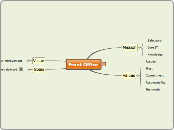logic and knowledge
Modern logic and its symbolic language
classic logic
How it´s help?
It help us to recognize elements of the arguments to concentrate above all the structor and determine their vadility
Development
it was developed in the nineteenth century by the englishmen George Boole and Augustus de Morgan.
is a logic in its broad sense one speaks of a class logic only if classes are descrived by a property of elements
Propositional logic
Also known as sentential logic and statement logic the branch of logic that studies ways to modify a statements perform more complicated propositions statements as well as the logical relationship and properties that are derived
Quantificational logic
This logic deal analyzing formally valid reasons based on their prepositions
The sylogism in classical logic
Structure consists of four proposition.
There are four types of proposition
they can be classifier by quantity and cality, and each one has a symbol.
A, E, I, O
Minor premiss , Major premiss ,Middle term and conclusion.
The logical principles of judgments and arguments.
Deductive inference
leads to necessay conclusions; part of the fact and absolute security.
principle of excluded middle
it tells us that by having two satment that contradict each other, necesarily one of them must be false and the other true.
principle of identity
the words and statments of our inferences must have the same and unique meaning throughout them.
Inductive inference
we start from various observations made about the same fact or object.
principle of non- contradiction
it is impossible to affirm that a proposition is true and false at the same time and under the same circumstance.
Principle of sufficient reason
to decide that a premiss is true or false , it is necessary to have reasons to support such a decision.
concept, judgement and reasoning
By the evaloution we start to reasoning.
capacity to speech.
Animal
use to different codes to communicate.
Human
use different codes to communicate.
reason and thought
capacirty to formulate a judgement and arguments









